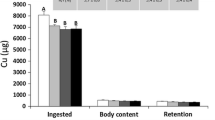Abstract
The potential of selenium-enriched rye/wheat sourdough bread as a route for supplementing dietary selenium intakes is reported. In addition to their normal diets, 24 female volunteers (24 to 25 years old) were fed either selenium-enriched bread or non-enriched bread each day (68.02 and 0.84 μg selenium day−1 respectively) for 4 weeks. The chemical form of the selenium in the bread had been characterised using HPLC-ICP-MS, which showed that 42% of the extractable selenium was present as selenomethionine. Plasma selenium levels and plasma platelet glutathione peroxidase (GPx1) activity were measured in the volunteers’ blood over a 6-week period. A statistically significant difference (p = 0.001) was observed in the mean percentage change data, calculated from the plasma selenium level measurements for the enriched and control group, over the duration of the study. A comparable difference was not observed for the platelet GPx1 activity (p = 0.756), over the same period. Two weeks after cessation of the feeding stage, i.e., at t = 6 weeks, the mean percentage change value for the selenium plasma levels in the enriched group was still significantly elevated, suggesting that the absorbed selenium had been incorporated into the body’s selenium reserves, and was then being slowly released back into the volunteers’ blood.

Similar content being viewed by others
References
Combs GF Jr (2001) Selenium in global food systems. Br J Nutr 85:517–547
Wasowicz W, Gromadzinska J, Rydzynski K, Tomczak J (2003) Selenium status of low-selenium area residents: Polish experience. Toxicol Lett 137 (1–2):95–101
Reilly CW (1996) Selenium in food and health. Blackie Academic & Professional, London
Rayman MP (2000) The importance of selenium to human health. Lancet 356:233–241
Beck MA, Shi Q, Morris VC, Levander OA (1995) Rapid genomic evolution of a non-virulent Coxsackievirus B3 in selenium deficient mice results in selection of identical virulent isolates. Nat Med 1(5):433–436
Nelson HK, Shi Q, Van Dael P, Schiffrin EJ, Blum S, Barclay D, Levander OA, Beck MA (2001) Host nutritional selenium status as a driving force for influenza virus mutations. FASEB J 15:1846–1848
Broome CS, McArdle F, Kyle J, Andrews F, Hart CA, Arthur JR, Jackson MJ (2002) Functional effects of selenium supplementation in healthy UK adults. Free Radic Biol Med 33(Suppl 1):S261–S264
Combs GF Jr, Clarke LC (1999) Selenium and cancer. In: Heber D, Blackburn GL (eds) Nutrition oncology. Academic, New York, pp 125–222
Ganther HE (1999) Selenium metabolism, selenoproteins and mechanisms of cancer prevention: complexities with thioredoxin reductase. Carcinogenesis 20:1657–1666
Arthur JR, McKenzie RC, Beckett GJ (2003) Selenium in the immune system. J Nutr 133:1457S–1459S
Ravaglia G, Forti P, Maioli F, Bastagli L, Facchini A, Mariani E, Savarino L, Sassi S, Cucinotta D, Lenaz G (2000) Effect of micronutrient status on natural killer cell immune function in healthy free-living subjects aged >/=90y. Am J Clin Nutr 71:590–598
Ursini F, Heim S, Kiess M, Maiorino M, Roveri A, Wissing J, Flohe L (1999) Dual function of the selenoprotein PHGPx during sperm maturation. Science 285:1393–1396
Bryszewska MA, Ambroziak W, Diowksz A, Baxter MJ, Langford NJ, Lewis DJ (2005) Changes in the chemical form of selenium during the manufacture of a selenium-enriched sourdough bread for use in a human nutrition study. Food Addit Contam 22:135–140
Gujska E, Majewska K (2005) Effect of baking process on added folic acid and endogenous folates stability in wheat and rye breads. Plant Foods Hum Nutr 60(2):37–42
Belsten JL, Wright AJ (1995) European community-FLAIR common assay for whole-blood glutathione peroxidase (GSH-Px): results of an inter-laboratory trial. Eur J Clin Nutr 49(12):921–927
Smith PK, Krohn RI, Hermanson GT, Mallia AK, Gartner FH, Provenzano MD, Fujimoto EK, Goeke NM, Olson BJ, Klenk DC (1985) Measurement of protein using bicinchoninic acid. Anal Biochem 150(1):76–85
Zachara B, Wasowicz W (1994) Selenium concentration in blood components of Polish sub-populations and in some other countries. Proceedings of the Scientific Session of the Polish Academy of Sciences. Arsenic and selenium in the environment. Polish Academy of Sciences, Warszawa, pp 104–109
Department of Health (1991) Dietary reference values for food energy and nutrients for the UK, COMA. HM Stationary Office, London
Ziemlanski S, Wartanowicz B, Panczenko-Kresowska J (1998) Zmiany w stanie zdrowia osób w wieku podeszlym z Warszawy w okresie 5 lat. Zyw Czlow Metab 2:111–121
Bryszewska MA, Ambroziak W, Rudzinski J, Lewis DJ (2005) The use of HPLC-ICP-MS to investigate the distribution of selenium in wheat flour proteins. Anal Bioanal Chem 382:1279–1287
Neve J (1995) Human selenium supplementation as assessed by changes in blood selenium concentration and glutathione peroxidase activity. J Trace Elem Med Biol 9:65–73
Brown KM, Pickard K, Nicol F, Beckett GJ, Duthie GG, Arthur JR (2000) Effects of organic and inorganic selenium supplementation on selenoenzyme activity in blood lymphocytes, granulocytes, platelets and erythrocytes. Clin Sci 98:593–599
Thomson CD, Robinson MF, Butler JA, Whanger PD (1993) Long-term supplementation with selenate and selenomethionine: selenium and glutathione peroxidase (EC 1.11.1.9) in blood components of New Zealand women. Br J Nutr 69:577–588
Neve J, Vertongen F, Capel P (1988) Selenium supplementation in healthy Belgian adults: response in platelet glutathione peroxidase activity and other blood indices. Am J Clin Nutr 48:139–143
Acknowledgements
This study was carried out with financial support through EC contract IC-IT-98-0193, “Improved Methods for the Production of Polish and Ukrainian Fermented Foods (IMPPUFF)”. MAB gratefully acknowledges KBN grant 6-P06G-057-20. Neill Walker is thanked for his contribution to discussions regarding the statistical approaches used in this work. This paper is dedicated to Rodger, brother of JL, who passed away, unexpectedly, during preparation of the manuscript.
Author information
Authors and Affiliations
Corresponding author
Rights and permissions
About this article
Cite this article
Bryszewska, M.A., Ambroziak, W., Langford, N.J. et al. The Effect of Consumption of Selenium Enriched Rye/Wheat Sourdough Bread on the Body’s Selenium Status. Plant Foods Hum Nutr 62, 121–126 (2007). https://doi.org/10.1007/s11130-007-0051-y
Received:
Accepted:
Published:
Issue Date:
DOI: https://doi.org/10.1007/s11130-007-0051-y




